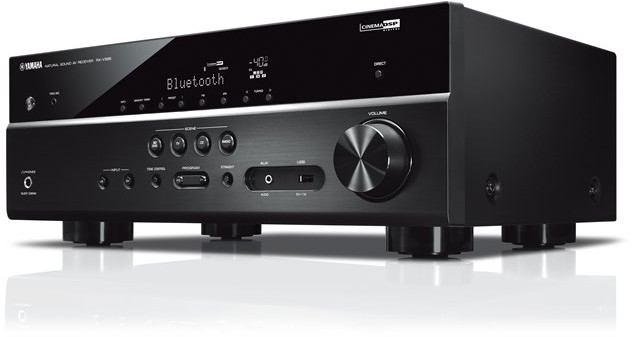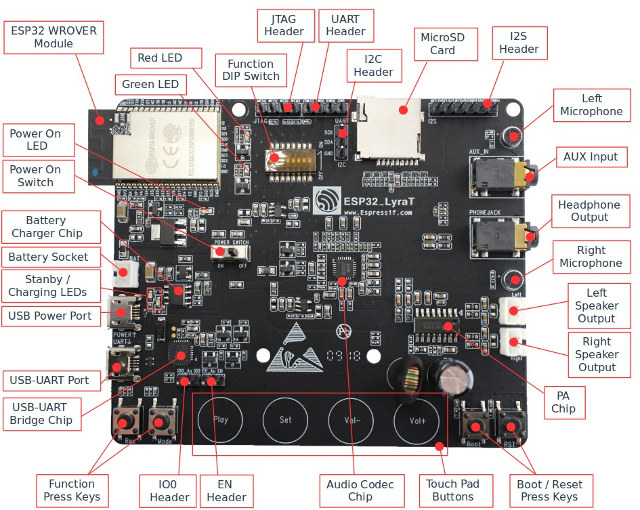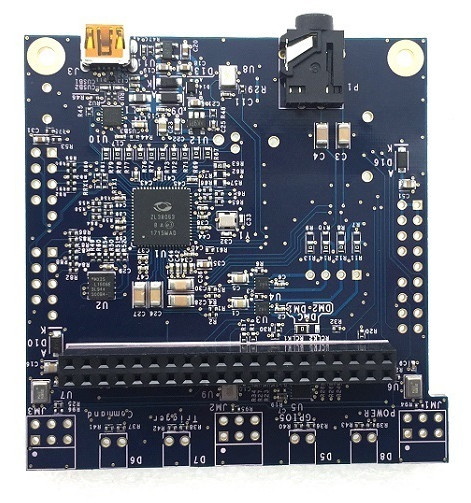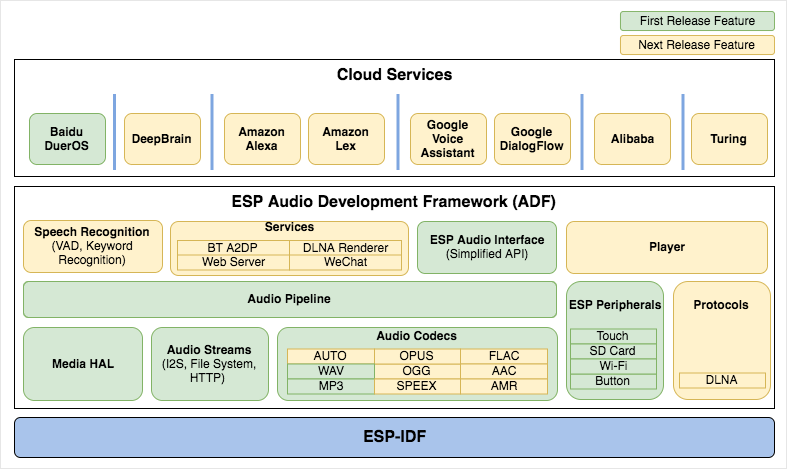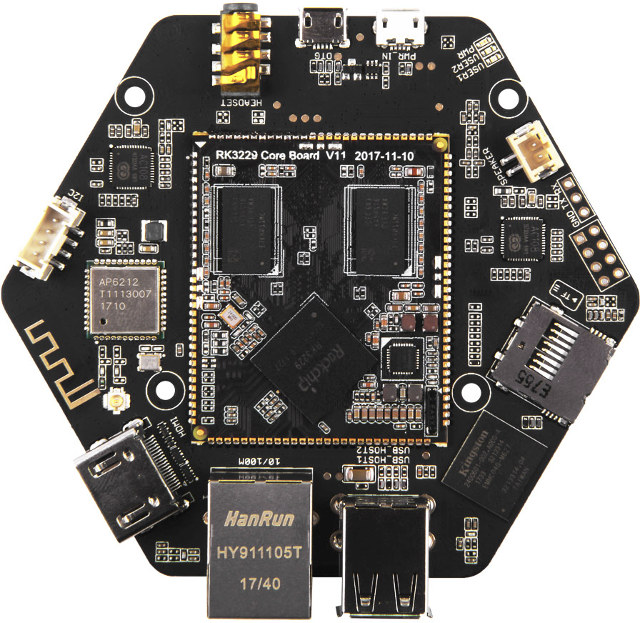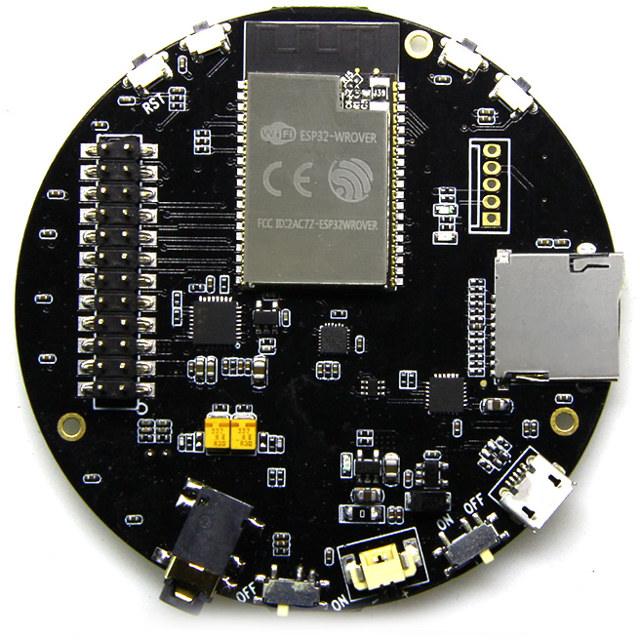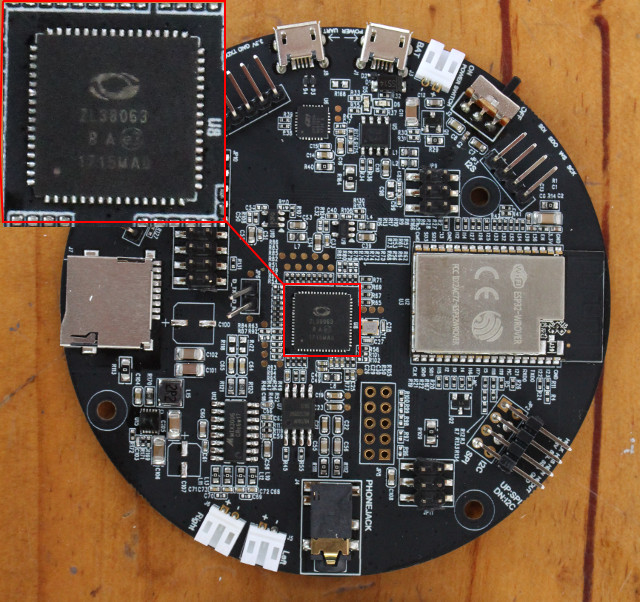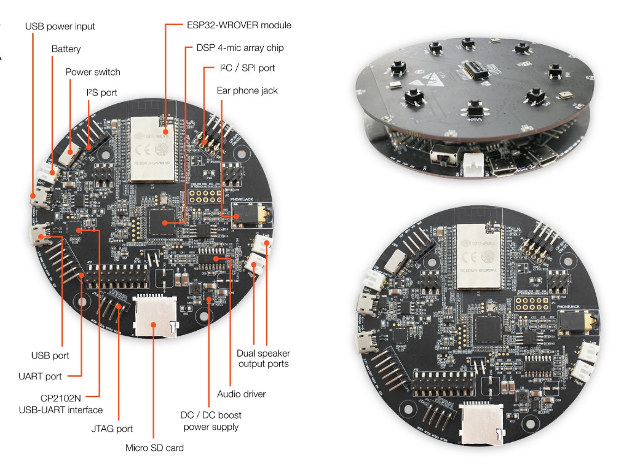HDMI 2.1 promises features such as 8K/10K video output, dynamic HDR, or enhanced audio return channel (eARC), but so far I had not seen any hardware boasting support for the new specifications. It’s not really surprising, as the HDMI Compliance Test Specifications (CTS) for HDMI 2.1 is expected to be released in stages starting in Q2 2018. While I have yet to see any HDMI 2.1 capable TV, Yamaha is already showing off a 5.1 A/V receiver allegedly HDMI 2.1 via their upcoming RX-V385 model that will be sold for $299.95 in the US. Key features listed by the company: 5.1-Channel powerful surround sound Bluetooth for wireless connectivity HDMI 2.1 with HDCP 2.2 (4 in/1 out) 4K Ultra HD support, HDR10, Dolby Vision, Hybrid Log-Gamma and BT.2020 YPAO auto-calibration technology for ideal sound That looks good, and if we look into the details specifications we can see HDMI eARC (part […]
ESP32-LyraT Speech Recognition Board Sold for 22 Euros
Just last week, we wrote about Espressif ESP-ADF Audio development framework that can be used to develop smart speakers and other audio applications with ESP32 boards. There was only one board with documentation at the time however: ESP32-Lyra-T. One tiny problem: it was not for sale just yet, but today Olimex has announced the board is in stock, selling it for 22 Euros. Main features: Wireless module – ESP32-WROVER module with WiFi and Bluetooth LE Audio Many audio inputs – Wi-Fi, BT-audio, DLNA, 3.5mm audio Line-in 3.5mm headphone jack 2x microphones Speaker connectors Storage – micro SD slot Debugging – JTGA header, USB UART Misc – Touch sense buttons, function/boot/reset keys, DIP switch for configuration Power – 5V via micro USB port; battery header + charger chip You’ll find documentation on Espressif website (user guide) as well as on Github’s ESP-ADF (getting started guide). Jean-Luc Aufranc (CNXSoft)Jean-Luc started CNX Software in […]
Banana Pi BPI-AI-Voice is a $169 Speech Recognition Development Kit based on MicroSemi ZL38063
SinoVoIP has just launched BPI-AI-Voice development platform for speech recognition on Aliexpress for $169, and excluding the different PCB color, it is a clone of the official $299 Microsemi AcuEdge Development Kit for Amazon AVS, which is based on MicroSemi ZL38063 audio processor and comes with two microphones. BPI-AI-Voice key features: Audio Processor – MicroSemi ZL38063 Storage – U2 SPI flash to store ZL38063 firmware Audio 4x on-board digital microphones (AKU441) supporting a 2 microphone configuration for 180° and 360° audio pick-up. 2x low cost class D audio amplifier (NCP2820) Expansion Headers JMMA1 audio header for digital microphone, analog out, and 3 GPIOs JM1-4 digital microphone headers for off-board microphones 40-pin P2 header to connected to Raspberry Pi 3 (I2S, SPI and 8x GPIO used) Debugging – JAIB2/2 auto tuning headers, micro USB port. Power Supply – 5V via micro USB port Dimensions – 70 mm × 66 mm Temperature […]
Espressif ESP-ADF Audio Development Framework for ESP32 Supports Baidu DuerOS, and Soon Amazon Alexa, Google Assistant, etc…
Espressif Systems have been working on audio applications like Smart Speakers based on ESP32 WiSoC with hardware development kits like ESP32-LyraTD-MSC Audio Mic HDK, and I could test it with Baidu DuerOS using Mandarin language. However, at the time (February 2018), there was not much else that could be done with the hardware kit, since no corresponding ESP32 audio software development kit had been made available. This has now changes since Espressif has just released ESP-ADF Audio Development Framework on Github. The framework will support the development of audio applications for the Espressif Systems ESP32 chip such as: Music player or recorder handling MP3, AAC, WAV, OGG, AMR, SPEEX … audio formats Play music from network (HTTP), storage (SD card), Bluetooth A2DP/HFP Integration with Media services such as DLNA, Wechat, etc.. Internet Radio Voice recognition and integration with voice services such as Alexa, DuerOS, Google Assistant As we can see […]
ReSpeaker Core v2 is a 6-Mic Array Audio Development Kit Powered by Rockchip RK3229 Processor
Seeed Studio launched ReSpeaker Core board designed for voice interaction in 2016. The board was based on a Mediatek MT7688 MIPS WiSoC running OpenWrt, and came with a single built-in microphone, although a microphone array board with 7 microphones and 12 LEDs was also offered as option. The company is now back with a more powerful update of the board – called ReSpeaker Core v2 – featuring Rockchip RK3229 quad core Cortex A7 processor, running Debian Linux, and with 6 on-board microphones. Beside WiFi connectivity, the board also adds Ethernet and Bluetooth 4.0, as well as a USB hot port compared to the previous version. ReSpeaker Core v2 specifications: SoC – Rockchip RK3229 quad core Cortex A7 processor @ up to 1.5 GHz with Arm Mali-400MP2 GPU System Memory – 1GB DDR3 RAM Storage – 4GB eMMC flash, micro SD card slot Video Output – HDMI 2.0 (but drivers not […]
TTGO TAudio V1.0 is a $20 Audio Board with ESP32-WROVER Module
Espressif Systems may have recently unveiled their Audio Mic HDK suitable for all sort of audio applications including smart speakers, but if you need an ESP32 board that’s available now and don’t need a microphone array, TTGO TAudio V1.0 board may be an option. The board – also known as TTGO T9 – features an ESP32-WROVER WiFI + Bluetooth module, a Wolfson audio codec with a 3.5mm audio jack and built-in microphone, as well as an RGB LED array and a motion tracking sensor. TTGO T9 / TAudio V1.0 board hardware specifications: Wireless Module – ESP32-WROVER 802.11 b/g/n + Bluetooth 4.1 LE module with 4MB Flash, 4MB PSRAM External Storage – micro SD card slot Audio Cirrus Logic / Wolfson WM8978 stereo audio codec 3.5mm audio jack Microphone Sensor – InvenSense MPU9250 9-Axis (Gyro + Accelerometer + Compass) MEMS device Expansion 24-pin header with GPIOs, I2C, UART, VP/VN, speaker out, […]
MicroSemi ZL38063 Audio Processor is Designed for Microphone Arrays
I’ve already been experimenting with DIY smart speakers and corresponding services for example using ReSpeaker board with Microsoft Bing Speech API, or Orange Pi Zero with Google Assistant SDK. But so far all the hardware platforms I used only came with one microphone, no microphone array that help with wake word detection in noisy environments. Last week-end, I received Espressif Audio Mic HDK, an ESP32 board with a 3-microphone array which I’ll review a in a few weeks once documentation becomes available and I clear some other items in my review list. In the meantime, I checked out the hardware, and found out the mainboard also comes with Microsemi ZL38063 audio processor specifically designed for microphone array. The chip was released las year, and can be already found in the company’s AcuEdge Development Kit for Amazon AVS, but since I’m going to use a board based on ZL38063 I’d thought […]
Espressif ESP32 LyraTD MSC HDK is Designed for Smart Speakers, Wireless Audio and other Smart Home Appliances
[Update February 17, 2018: The kit was previously referred as ESP32 LyRaTD MS1, but the company appears to have changed the name to ESP32-LyRaTD-MSC] So apparently voice command will represent 50% of all searches in the next two years, and everybody is jumping on the smart speaker bandwagon, with announcements from many companies at CES 2018, including Google’s Android Things + Assistant products‘ announcement, NXP i.MX 8M official launch, Amazon Alexa Voice Service (AVS) development kit from Amlogic and Allwinner, and more. Espressif Systems is about to join the party with their ESP32 LyraTD MS1 HDK (Hardware development kit) that most people will likely remember as “Audio Mic HDK” that was announced on Twitter. Espressif Audio Mic HDK specifications: Wireless Module – ESP32-WROVER module with 802.11 b/g/n WiFi and Bluetooth 4.1 LE connectivity. DSP – 4-mic array chip Storage – micro SD card for audio files Audio Audio driver chip […]


